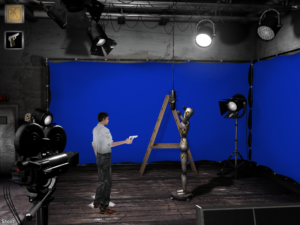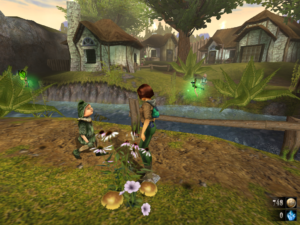Well, the Vintage Game Club is proceeding on to its next game , so I think it’s about time to admit to myself that I’m not finishing up the JRPGs just yet and proceed on to something else. Something nice and quick to finish, like an adventure game. I still have a passel of obscure European graphic adventures that I was formerly unable to play due to the GeForce bug.
So, last night, I reinstalled a couple of games, feeling kind of strange about it — it’s been quite a few months since I ran an installer from physical media. First, I tried out Ring 2, the second part of Arxel Tribe’s sci-fi adaptation of Wagner’s Ring cycle. Sound issues drove me away from this; if there’s one place you don’t want the music to be skipping and stuttering, it’s in a game based on opera. My second attempt was another Arxel Tribe title, The Final Cut. This had similar sound problems, but I was able to mitigate them with some fiddling. I still get some ugliness in incidental background noises, but at least the dialogue seems to be playing without problems.
The grand concept behind The Final Cut is that it’s based on, or at least inspired by, the works of Alfred Hitchcock. An oddball premise, but adventure games can get away with such things more easily than other genres. I haven’t got far in the game yet (I’m basically at the point where I abandoned it the first time), but so far, it doesn’t strike me as a very good match to the source material. I mean, if I were going to make a Hitchcock pastiche, I’d start off with the stereotypical Hitchcock protagonist: an ordinary man who, through no fault of his own, gets caught up in events beyond his control, like in North by Northwest and The Man Who Knew Too Much. Not all of his films have such a protagonist; sometimes it’s a spy or a master thief or something, but those sorts of roles aren’t specifically Hitchcockian; anyone can make a film about spies or master thieves. Well, the player character here is apparently some kind of psychic detective, which seems a bit outlandish. That’s the kind of premise you’d start with if you had heard of Hitchcock but had never seen his films. Or, more charitably, if you thought players wouldn’t be attracted to playing the Jimmy Stewart role.
The game is driven by the same sort of interface seen in Grim Fandango, which is to say, it’s the Alone in the Dark interface with the addition that the player character turns his head to look at important objects (something that worked a lot better in GF, due to the PC’s freakishly elongated cranium). In this UI, you drive your avatar around with keyboard or joystick, and the camera switches between fixed positions depending on your position. And this is the game’s second stumbling block as a Hitchcock imitation — that the camera is controlled exclusively by the player’s position. Hitchcock’s directorial style heavily depends on his control of the camera: I think of the way it emphasizes the separation between inside and outside in Rear Window, or creates tension by lingering on the impromptu casket in Rope, or how in Frenzy it follows a woman to the killer’s door, watches her go through, and then slowly backs off the way it came, as if abandoning her to her fate (and thus forcing the audience to abandon her as well). But here, even in noninteractive bits — which is to say, the dramatic parts — the camera just sits there. I suppose that even with an engine like this, you could give the director control of the camera in FMV sequences, but so far the only FMV bit I’ve seen is the intro.
So, if we don’t have Hitchcock-style premise or direction, what, apart from the blurb on the box, lets us know it’s a Hitchcock game? Well, there are scattered references to specific films — in particular, one of the early puzzles involves piecing together film titles from fragments. And I think the sets are probably from his films. (Note that when I say “sets”, I mean sets: the premise involves a wealthy eccentric who’s making a film on his estate.) I’m not sure of this because, frankly, most of Hitchcock’s sets aren’t all that distinctive. Maybe a real devotee would look at the hotel set and say “Aha! It’s the hotel from scene 17 of Topaz!” But people like me, who have seen a bunch of Hitchcock films and enjoyed them but didn’t rush out to buy the action figures , can probably recognize the Psycho house and maybe the schoolyard from The Birds, and that’s it.
 In short, so far this is Alfred Hitchcock: The Game in the same sense as Batman: The Ride. Still, there’s one bit that I’ve come across that seems like it fits the spirit of the films pretty well. Standing in for a missing actor, the player character gets in front of a bluescreen and mimes shooting at a dummy. As I go through that sequence, I know full well that it’s going to come back to haunt me later — I’m basically giving the filmmakers the raw materials to fabricate evidence that I’ve shot someone. And I can only assume that I was supposed to realize this, even as the PC blithely goes through with it, because that’s how suspense works: as in the famous example of the ticking bomb, it’s enhanced if the audience knows something that the characters don’t. But in a game, it can be taken a step farther: the audience doesn’t just watch the hapless protagonist do the wrong thing, but actively participates. Step by step, you’re given directions — “Stand on the X”, “Draw the gun now and point it at the dummy”, and so forth — and you execute them, because however strong your sympathy with the protagonist, your desire to advance the plot is stronger.
In short, so far this is Alfred Hitchcock: The Game in the same sense as Batman: The Ride. Still, there’s one bit that I’ve come across that seems like it fits the spirit of the films pretty well. Standing in for a missing actor, the player character gets in front of a bluescreen and mimes shooting at a dummy. As I go through that sequence, I know full well that it’s going to come back to haunt me later — I’m basically giving the filmmakers the raw materials to fabricate evidence that I’ve shot someone. And I can only assume that I was supposed to realize this, even as the PC blithely goes through with it, because that’s how suspense works: as in the famous example of the ticking bomb, it’s enhanced if the audience knows something that the characters don’t. But in a game, it can be taken a step farther: the audience doesn’t just watch the hapless protagonist do the wrong thing, but actively participates. Step by step, you’re given directions — “Stand on the X”, “Draw the gun now and point it at the dummy”, and so forth — and you execute them, because however strong your sympathy with the protagonist, your desire to advance the plot is stronger.
Hitchcock was no stranger to audience complicity, of course: he knew full well that people would pay good money to see him take sympathetic characters and put them through the worst day of their lives. He sometimes even made his audience feel like accomplices in his virtual crimes, as in the aforementioned scene in Frenzy, or the cleaning-up scene in Psycho, where the tension depends on the audience’s desire, at that moment, for the killer to get away with it. But it’s so much more direct in a game.
 Comments(2)
Comments(2)
